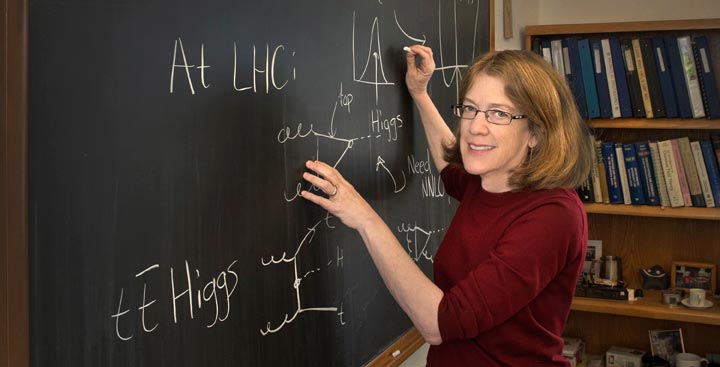Brookhaven Lab 'Higgs Hunter' Sally Dawson Receives Humboldt Research Award
June 4, 2015
 enlarge
enlarge
Sally Dawson, a theoretical physicist at Brookhaven Lab, received a prestigious Humboldt Research Award that includes an invitation to spend up to one year in Germany working on precise calculations for the long-sought Higgs boson
UPTON, NY — Sally Dawson, a theoretical physicist at the U.S. Department of Energy's Brookhaven National Laboratory, has received a prestigious Humboldt Research Award for her life's work, which includes research on the long-sought Higgs boson and precise calculations of the particle's properties. The prize includes an invitation for Dawson to spend up to a total of one year cooperating on long-term research with colleagues at a research institution in Germany along with 60,000 euros to support her efforts.
The Alexander von Humboldt Foundation grants up to 100 of these awards each year to researchers like Dawson whose fundamental discoveries, new theories, or insights have had a significant impact on their own discipline and who are expected to continue producing cutting-edge achievements in the future. Since 1974, 12 other Brookhaven physicists have received the Humboldt prize.
"Many of my colleagues are in Germany, so I'm honored and grateful to receive this award for the opportunity to continue precise calculations of the Higgs' production and decay rates," said Dawson, who plans to begin her semiannual travels to Germany in January 2016. During her time there, Dawson plans to collaborate primarily with fellow physicist Barbara Jaeger at the University of Tuebingen in southern Germany.
Hunting for the Higgs
Dawson has been on the Higgs' trail for decades, developing mathematical models to explain and predict the processes in which Higgs particles are produced. The Higgs is a subatomic particle thought to give mass to other elementary particles in the Standard Model of particle physics—the theory that describes all known fundamental particles and explains how they interact.
"You need precise theoretical calculations to see a Higgs particle, because the calculations tell you what to look for and where you may find one," Dawson explained.
Scientists discovered the Higgs at the Large Hadron Collider (LHC) at CERN in Europe in 2012, and this discovery contributed to the 2013 Nobel Prize in Physics, which was awarded to two theoretical physicists who predicted the particle's existence nearly fifty years earlier. Today, Dawson and her colleagues are collaborating to more accurately predict the production and decay processes for Higgs particles at the LHC.
"The calculations are becoming increasingly complex," Dawson said. "The more contributions we include in the overall equations—calculations for quarks, bosons, and other fundamental particles that interact with the Higgs—the more accurate our predictions become. We get creative in figuring out how to put the pieces together and I'm looking forward to pursuing some new ideas with my colleagues in Germany."
Dawson joined Brookhaven Lab's Physics Department in 1986 after earning a B.S. in physics and mathematics from Duke University in 1977 and a Ph.D. in physics from Harvard University in 1981. She was a research associate at Fermilab from 1981 to 1983 and Lawrence Berkeley National Laboratory from 1983 to 1986. After arriving at Brookhaven Lab, Dawson rose through the ranks, leading the High Energy Theory Group from 1998 to 2004 and the Physics Department as chair from 2005 to 2007 before returning to research in 2008.
Dawson is co-author of the book "The Higgs Hunter's Guide," and has been an adjunct professor at Stony Brook University's Yang Institute for Theoretical Physics since 2001. She was named a fellow of the American Physical Society in 1995 and the American Association for the Advancement of Science in 2006.
Dawson's research at Brookhaven is supported by the DOE Office of Science.
Brookhaven National Laboratory is supported by the Office of Science of the U.S. Department of Energy. The Office of Science is the single largest supporter of basic research in the physical sciences in the United States, and is working to address some of the most pressing challenges of our time. For more information, please visit science.energy.gov.
2015-11735 | INT/EXT | Newsroom









